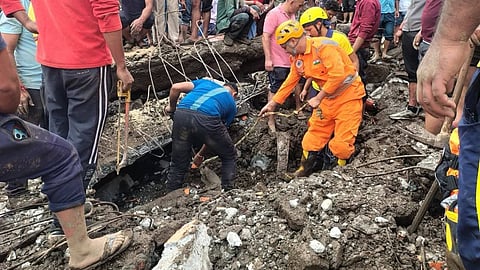

Flash floods triggered by heavy rains in Uttarakhand's Nandanagar have left 12 people missing and caused extensive damage in Chamoli district.
Rescue operations are underway, with 300 residents evacuated and several buildings damaged.
The India Meteorological Department reported 70 mm of rainfall in 24 hours, attributing the floods to high water levels and saturated land conditions.
Heavy rains in Uttarakhand have triggered flash floods in Nandanagar, Chamoli district, causing extensive damage and leaving 12 people missing. Authorities believe the missing may be buried under debris. Around 300 residents from affected areas have been evacuated.
India Meteorological Department (IMD) has clarified that no cloudburst occurred in the region, though the area received heavy rainfall.
Uttarakhand had received heavy rainfall two days ago as well, which led to 13 deaths in the state capital Dehradun.
According to Secretary of State Disaster Management and Rehabilitation Vinod Kumar Suman, heavy rain around 3 am on the night of September 18-19 sent water and debris cascading into the villages of Kuntari Lagafali, Kuntari Laga Sarpani and Dhurma.
In Kuntari Lagafali, eight people are missing and feared buried. Between 15 and 20 houses and a cowshed have been reported damaged. Teams from the local police, the State Disaster Response Force (SDRF) and the revenue department rescued two women and a child trapped under debris; they have been admitted to the Community Health Centre in Nandanagar. A further 150-200 villagers were moved to safer locations.
In Kuntari Laga Sarpani, two people are missing and two buildings have been damaged. Around 100 villagers were evacuated.
The Moksha River, swollen by heavy rain, has caused flooding in Dhurma village. Two people are reported missing and between eight and ten buildings have sustained damage.
Rohit Thapliyal, senior meteorologist at IMD, told Down To Earth that while Chamoli district overall recorded moderate rainfall, Nandanagar registered 70 millimetres in 24 hours. He clarified that this data came via the District Disaster Management Office, since Nandanagar does not have a IMD observatory.
Thapliyal added that the flash floods were likely the result of already high water levels in rivers and streams, coupled with the land’s exhausted water-holding capacity. “This caused the water to rush down, carrying debris,” he said.